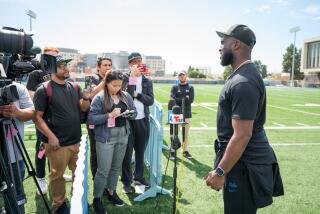Re-Imagining Dodger Stadium as Urban Center
- Share via
For sale: a 330-acre hillside property with spectacular views of downtown skyscrapers. Freeway close, ample parking. This 1962 fixer can accommodate 56,000 visitors around beautiful lawns. Potential uses include TV studio, sports theme park, restaurants or an entirely new neighborhood of apartments and stores.
That might be the sales plug for Dodger Stadium, now that the O’Malley family has put the Los Angeles baseball team and its properties up for bid.
Conventional wisdom holds that the Dodgers’ next owner will have to find new ways to extract revenue from the Dodger properties to justify the huge purchase price the club is expected to command. So, physical changes inside the beloved ballpark and to its 17,000-space parking lots may be ahead, tantalizing some Angelenos and infuriating others. The debate might turn spicier than a Red Hot stadium dog spiked with jalapenos on a summer night.
“There is no question, it is one of the most underutilized key parcels in the whole metropolitan area, and I think there is a whole set of activities that could be conceived to make the area used by a whole lot more people and used a whole lot more of the time,” said Richard Peiser, director of the Lusk Center for Real Estate Development at the USC School of Urban Planning and Development.
His opinion is contested by some experts who think that Chavez Ravine is too isolated and too hilly for anything but sports-related businesses to succeed, such as the football stadium previously proposed by Peter O’Malley. And area residents and protectors of adjacent Elysian Park pledge to fight any development that will add traffic and pollution.
An informal survey of leaders in the sports, arts, architecture, planning and retail industries revealed expectations, hopes and fears. The consensus was that any additions to the stadium area would have to be very special and have a sports flavor, not just a copy of Universal City’s CityWalk or a mall with movies and sneaker shops.
Alan Feldman, vice president of public affairs for Mirage Resorts Inc., described himself as conflicted. The Dodger loyalist side of him “is scared to death,” he said, of changes that could ruin the stadium’s everyman atmosphere and hike ticket prices. Yet the Las Vegas hotelier and entertainment businessman also is certain that a new owner will seek to boost visitors’ spending.
“How can you look at that and not think about using it for more than 81 revenue nights,” he said. “The point is there are 365 days a year.”
The right balance between tradition and innovation might be a baseball theme park, possibly called Dodgertown, next to the stadium, he said. High-tech batting cages, interactive displays of baseball history, sports breweries and sales of memorabilia could all play a part. Think about virtual reality Sandy Koufaxes pitching to wannabe major leaguers.
“For all those people from New York who still yearn for the days when the Bums were around, they can dodge some trolley cars,” Feldman said, suggesting a recreation of the Brooklyn transit scene that led to the team’s name.
When O’Malley last year proposed an NFL football stadium, early drawings showed a promenade of shops and restaurants connecting it to Dodger Stadium. Now, with the football stadium at least temporarily shelved, informed observers offer such additional and divergent ideas as a conference center, an early ‘60s-style drive-in movie theater and a grand complex for outdoor recreation.
Ticketmaster President Fred Rosen agreed that an entertainment complex in Chavez Ravine might include amateur sports and interactive games. But, given the competition in Southern California, it must provide visitors a compelling reason not to seek entertainment closer to home, Rosen said.
“This is a crown jewel of an asset,” Rosen said. “What is there should be unique.”
Besides stressing a sports theme, new owners should market the shimmering panoramas of downtown, said David Wilcox, a senior vice president of Economics Research Associates in Los Angeles. “There is an opportunity for specialty restaurants and retailing, things of that nature, to take advantage of looking out over this vast urban place. It’s a very handsome view,” he said.
Because Dodger Stadium is such a profound symbol of civic unity, sports historian Paul Zingg urged something “more ambitious and more eloquent” than a shopping promenade. He called for parts of the parking lot to be made into public playing fields for baseball, softball, soccer and football. Adjacent cafes and shops could generate income.
“I’m talking about something grand, something that makes a statement about the value of the sporting culture,” said Zingg, who is provost and vice president for academic affairs at Cal Poly San Luis Obispo and was a consultant to the Ken Burns’ PBS television series on baseball. “That whole area could become sort of a celebration of sports and recreation as opposed to simply commercialism.”
Many urban planners have turned against the Dodger Stadium model, a free-standing behemoth in a sea of surface parking. In cities such as Baltimore and Cleveland, new baseball stadiums and sports arenas are in the urban center, with easy pedestrian access to neighborhood restaurants and offices. In fact, plans for a hockey and basketball arena next to the downtown Los Angeles Convention Center won political support because it is expected to boost the economy on surrounding blocks.
Since Dodger Stadium probably won’t move, why not build neighborhoods and garages around it instead? That’s a concept raised by Terry Bottomley, a principal in the Freedman, Tung and Bottomley urban design firm.
“You could grow Chinatown. You could grow more city and run streets right up to the edge,” said Bottomley, based in San Francisco. “To me, big acres of surface parking in an urban setting is a waste of land.”
A similar idea was supported by USC’s Peiser, who thinks that any retail development in Chavez Ravine would need bolstering by additional housing, possibly for professionals working downtown. The sales pitch could emphasize proximity to Elysian Park, which Peiser described as one of the city’s great open spaces, even if it is not well-maintained.
Such concepts raise skepticism and opposition. Not the least of which would come from Dodger fans who consider the open-air parking an Angeleno birthright, along with the chance to leave after the seventh inning to beat the traffic.
Con Howe, planning director for the city of Los Angeles, stressed that many other properties throughout downtown are better for commercial and residential development and certainly more convenient to jobs. Howe also questioned whether there would be much demand for restaurants and shops. “Frankly, do people going to a ballgame care much about the food experience? Most people who go there like the Dodger dogs,” he said.
While the freeways provide good access, they also cut off Chavez Ravine from the city, said architect and planner Stefanos Polyzoides, of the Los Angeles-based Moule & Polyzoides firm. “It’s a very isolated place that doesn’t exactly give itself to generating any other intense use,” he said. And the proximity to low-income neighborhoods like Echo Park might, rightly or wrongly, scare off upscale buyers of potential housing, he said.
And, as with the now-stalled football plan, any proposal would face protests from area residents who long have felt trapped by stadium traffic.
“What we have here is a situation at stress level. We cannot accommodate more development in that area,” said Sallie Neubauer, president of Citizens Committee to Save Elysian Park.
Before selling the team, O’Malley should donate parcels of hilly grassland near the stadium to Elysian Park, Neubauer said. Those Dodger parcels are now used as a Fire Department helicopter pad and for some overflow parking near the Los Angeles Police Academy. She also asked that many trees be planted throughout the Dodger parking lots, “so when you look out from Elysian Park, you would not be confronted with that huge glare of asphalt.”
While anything new outside the stadium will face a political battle, chances are better for changes inside, most observers say. Those proposals include improvements to the food counters, more advertising signage, a more technologically advanced scoreboard, and high-priced private seating suites.
The goal should be to keep what people treasure about the stadium’s friendly nature and to hold down prices of general admission seats, they said.
Dodger Stadium is “the finest stadium in the country of its era,” said architect Michael Hallmark of NBBJ Architecture Sports and Entertainment, a Los Angeles firm that worked on the football proposal for Chavez Ravine and is designing new stadiums in Seattle and Milwaukee. But he added that “anything that old deserves a serious reworking.”
Also at NBBJ, architect Dan Meis suggested that any face-lift stress the styles of and nostalgia for the late ‘50s, when the Dodgers arrived on the West Coast. (That might include a drive-in movie theater on the parking lot, he said.)
The O’Malleys have been conservative in renting out the stadium, fearing that rock concerts might damage the stadium and antagonize neighbors. (No concerts and no religious meetings were held in the stadium in 1996.) The Los Angeles area has many concert halls and amphitheaters with better acoustics and more intimate settings. So a new owner should not count on Dodger Stadium as a major arts venue, experts said.
“You can fill it only if you have extraordinary, once-in-a-lifetime events with superstars,” said Robert Fitzpatrick, whose credentials including heading CalArts, the Los Angeles Olympic Arts Festival and the EuroDisney theme park. He cited the success of the “Three Tenors” concert in 1994 at the stadium.
Now the dean of the School of the Arts at Columbia University in New York, Fitzpatrick suggested that high-tech entertainment studios might be built on the stadium parking lots. “This is one of the logical places where you could create another whole studio or an L.A. equivalent of Silicon Valley,” he said.
Times staff writer James Bates contributed to this story.
More to Read
Go beyond the scoreboard
Get the latest on L.A.'s teams in the daily Sports Report newsletter.
You may occasionally receive promotional content from the Los Angeles Times.











